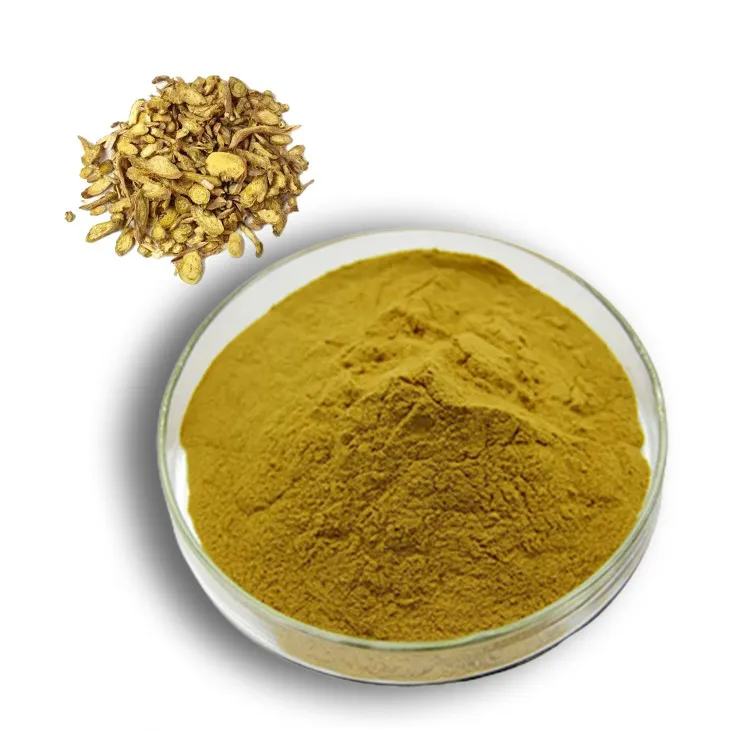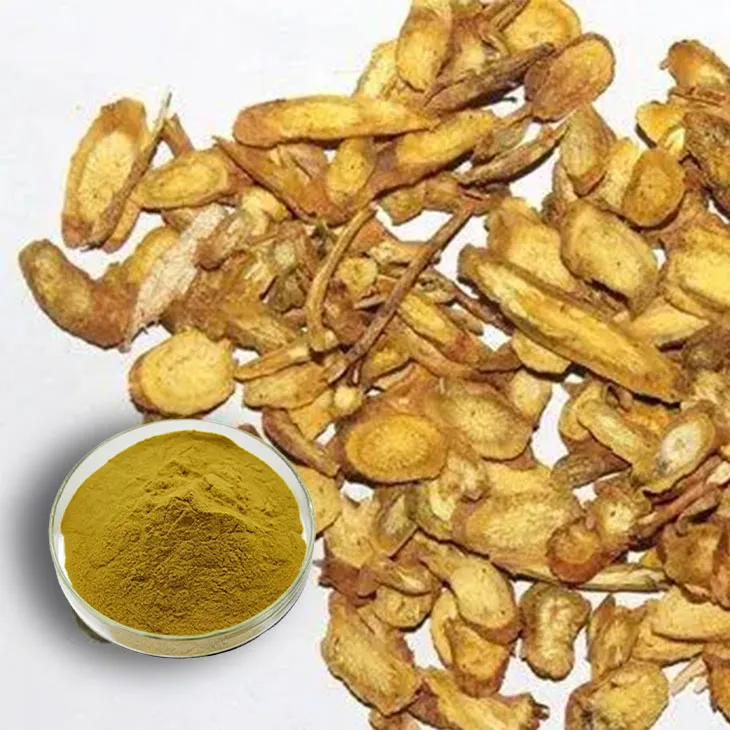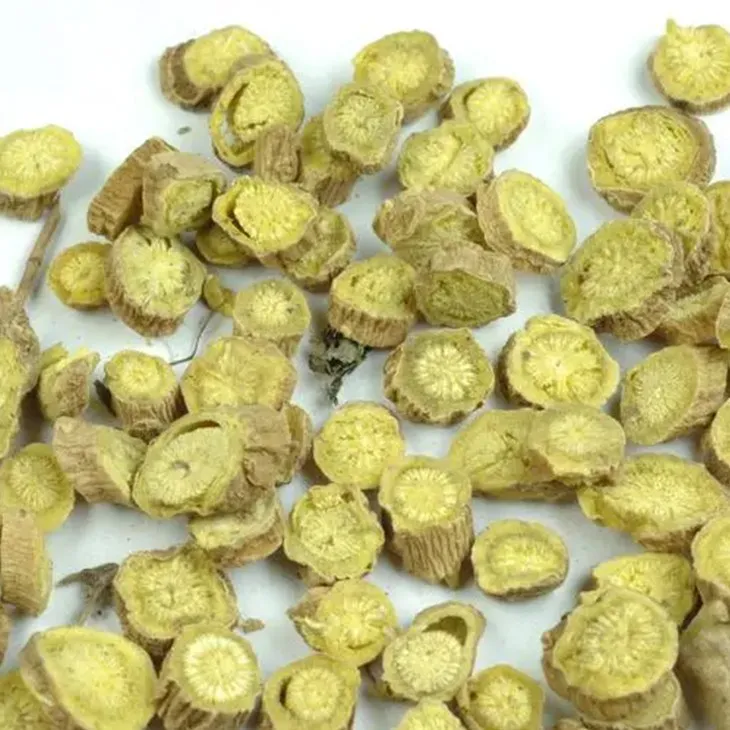- 0086-571-85302990
- sales@greenskybio.com
Benefits of Baicalin in Cattle Feed.
2024-11-14

Introduction
Baicalin, a natural compound, has emerged as a potentially valuable addition to cattle feed. In modern livestock production, there is a continuous search for natural substances that can enhance the health and productivity of animals. Baicalin offers a range of benefits that can contribute to the overall well - being of cattle. This article will explore in detail the multiple advantages of including Baicalin in cattle feed.

Antioxidant Properties of Baicalin
1. Understanding Oxidative Stress in Cattle
- Oxidative stress occurs when there is an imbalance between the production of reactive oxygen species (ROS) and the antioxidant defense mechanisms in the body of cattle. ROS are natural by - products of normal cellular metabolism, but when their levels become excessive, they can cause damage to cells, proteins, lipids, and DNA.
- In cattle, oxidative stress can be triggered by various factors such as environmental stressors (e.g., heat, cold, poor air quality), nutritional imbalances, and diseases. This can lead to reduced performance, weakened immune function, and increased susceptibility to various health problems.
- Baicalin has antioxidant properties that help to counteract oxidative stress in cattle. It can scavenge free radicals, which are highly reactive molecules that contribute to oxidative damage.
- Studies have shown that baicalin can increase the activity of antioxidant enzymes in the body of cattle, such as superoxide dismutase (SOD), catalase (CAT), and glutathione peroxidase (GSH -Px). These enzymes play crucial roles in neutralizing ROS and maintaining the redox balance within cells.
- By protecting cells from oxidative damage, baicalin can help to maintain the integrity of various tissues in cattle, including the liver, muscles, and immune cells. This is important for the overall health and productivity of the animals.

Enhancement of the Immune System
1. The Immune System in Cattle
- The immune system of cattle is a complex network of cells, tissues, and molecules that work together to protect the animals from pathogens such as bacteria, viruses, and parasites. A strong immune system is essential for the health and survival of cattle, especially in the face of various environmental and disease challenges.
- The immune response in cattle can be divided into two main types: the innate immune response, which provides immediate, non - specific defense against pathogens, and the adaptive immune response, which is more specific and long - lasting.
- Baicalin has been shown to enhance the immune system of cattle. It can stimulate the activity of immune cells such as macrophages, neutrophils, and lymphocytes.
- Macrophages are phagocytic cells that play a key role in the innate immune response by engulfing and destroying pathogens. Baicalin can increase the phagocytic activity of macrophages, making them more efficient at clearing infections.
- Neutrophils are also important for the innate immune response, and baicalin can enhance their ability to migrate to the site of infection and kill pathogens. Lymphocytes, on the other hand, are central to the adaptive immune response, and baicalin can modulate their function, promoting a more effective immune response against specific pathogens.
- Furthermore, baicalin can also regulate the production of cytokines, which are signaling molecules that play important roles in the immune response. By modulating cytokine production, baicalin can help to balance the immune response, preventing excessive inflammation and promoting tissue repair.

Improvement of Digestion and Nutrient Absorption
1. The Digestive Tract of Cattle
- Cattle have a complex digestive system, which is designed to process large amounts of fibrous plant material. The digestive tract of cattle consists of several compartments, including the rumen, reticulum, omasum, and abomasum. Each compartment plays a specific role in the digestion and fermentation of feed.
- In the rumen, which is the largest compartment, a diverse community of microorganisms (bacteria, protozoa, and fungi) ferments the feed, breaking down complex carbohydrates such as cellulose and hemicellulose into simpler compounds that can be absorbed by the animal.
- Baicalin has the potential to improve the digestion and absorption of nutrients in the digestive tract of cattle. It can influence the microbial population in the rumen, promoting the growth of beneficial microorganisms while inhibiting the growth of harmful ones.
- Beneficial microorganisms in the rumen are important for the efficient fermentation of feed, as they produce enzymes that break down complex carbohydrates and proteins. By promoting the growth of these microorganisms, baicalin can enhance the digestion of feed, increasing the availability of nutrients for absorption.
- Baicalin can also improve the integrity of the intestinal mucosa in cattle. The intestinal mucosa is the lining of the small intestine, which is responsible for the absorption of nutrients. A healthy intestinal mucosa is essential for efficient nutrient absorption, and baicalin can help to maintain its integrity by reducing inflammation and oxidative damage.
- In addition, baicalin may enhance the function of transport proteins in the intestinal mucosa, which are involved in the uptake of nutrients such as amino acids, sugars, and minerals. By improving the function of these transport proteins, baicalin can further increase the absorption of nutrients, promoting the growth and development of cattle.

Conclusion
In conclusion, baicalin offers multiple benefits when added to cattle feed. Its antioxidant properties help to combat oxidative stress, protecting the cells of cattle from damage. It also enhances the immune system, enabling the animals to better resist diseases. Moreover, baicalin improves the digestion and absorption of nutrients in the digestive tract, promoting the growth and development of cattle. As the demand for natural and sustainable solutions in livestock production continues to grow, baicalin has the potential to become an important component in cattle feed formulations. However, further research is still needed to fully understand the optimal dosage, long - term effects, and potential interactions of baicalin in cattle feed. With continued research and development, baicalin could play a significant role in improving the health and productivity of cattle in the future.
FAQ:
1. What are the antioxidant mechanisms of baicalin in cattle?
Baicalin contains phenolic hydroxyl groups which can scavenge free radicals. It can donate hydrogen atoms to free radicals, thereby neutralizing them and preventing oxidative reactions that could damage cells in cattle. Additionally, it may upregulate antioxidant enzymes in the body of cattle, such as superoxide dismutase (SOD) and glutathione peroxidase (GSH - Px), to enhance the overall antioxidant capacity.
2. How does baicalin enhance the immune system of cattle?
Baicalin can modulate the immune response in cattle. It may stimulate the production and activity of immune cells, like macrophages and lymphocytes. Macrophages are important for phagocytosing pathogens, and lymphocytes play a crucial role in the adaptive immune response. Baicalin might also regulate cytokine production, which helps in coordinating the immune system's defense against diseases.
3. Can baicalin replace other growth - promoting additives in cattle feed?
While baicalin has the potential to promote growth by improving nutrient digestion and absorption, it may not completely replace all other growth - promoting additives. Different additives have different functions. However, it can be a valuable component in cattle feed as part of a comprehensive approach to promoting growth. It may work in synergy with other beneficial substances, but more research is needed to determine its full potential as a replacement or complementary additive.
4. How much baicalin should be added to cattle feed?
The optimal amount of baicalin to be added to cattle feed depends on various factors such as the age, weight, and health status of the cattle, as well as the composition of the rest of the feed. Currently, research is still ongoing to determine the exact dosage. Preliminary studies suggest that a certain concentration range may be effective, but it is crucial to conduct more in - depth research to establish accurate and safe dosage guidelines.
5. Are there any potential side effects of baicalin in cattle feed?
So far, no significant adverse side effects of baicalin in cattle feed have been widely reported. However, as with any feed additive, over - dosage or improper use may lead to potential problems. It is important to ensure that the addition of baicalin is within a reasonable range and that the quality of the baicalin used is reliable. Continued research is also needed to monitor any long - term or subtle effects.
Related literature
- The Role of Baicalin in Animal Health and Nutrition"
- "Beneficial Effects of Natural Compounds like Baicalin in Livestock Feed"
- "Baicalin: A Promising Additive for Cattle Feed - Recent Research Findings"
- ▶ Hesperidin
- ▶ Citrus Bioflavonoids
- ▶ Plant Extract
- ▶ lycopene
- ▶ Diosmin
- ▶ Grape seed extract
- ▶ Sea buckthorn Juice Powder
- ▶ Fruit Juice Powder
- ▶ Hops Extract
- ▶ Artichoke Extract
- ▶ Mushroom extract
- ▶ Astaxanthin
- ▶ Green Tea Extract
- ▶ Curcumin
- ▶ Horse Chestnut Extract
- ▶ Other Product
- ▶ Boswellia Serrata Extract
- ▶ Resveratrol
- ▶ Marigold Extract
- ▶ Grape Leaf Extract
- ▶ New Product
- ▶ Aminolevulinic acid
- ▶ Cranberry Extract
- ▶ Red Yeast Rice
- ▶ Red Wine Extract
-
Beetroot juice Powder
2024-11-14
-
Passionflower Extract
2024-11-14
-
Nettle leaf extract
2024-11-14
-
Green Tea Extract
2024-11-14
-
Yam Extract
2024-11-14
-
Eucommia Ulmoides Extract
2024-11-14
-
Black Pepper Extract
2024-11-14
-
Black Rice Extract
2024-11-14
-
Shikonin
2024-11-14
-
Sea buckthorn Juice Powder
2024-11-14





















